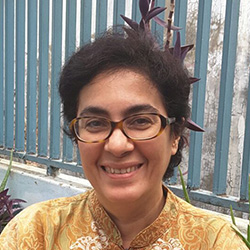In Indonesia, social forestry gets socialized
One challenge with social forestry is that its inner-workings aren’t always understood – often among communities involved in it most. This is why a team of scientists has published a new guidebook that makes this complex form of forest management easier to understand.
By explaining in simple terms the legal logistics of how local communities manage different forest areas, the guidebook serves as a reference to government officials and community assistants in the field.
Through this, it aims to help local communities gain tenure for the forests they manage, as is summed up in the title of the book: Practical Application Guidelines on Social Forestry Policy in the Acceleration of the Forest Tenure Reform.
“One of the major challenges causing slow forest tenure reforms is the lack of knowledge of people on the ground on its legal aspects and stages of the reform process,” says Nining Liswanti, Researcher at the Center for International Forestry Research (CIFOR), who led the project of producing the guidebook.
The book – which CIFOR developed in cooperation with Jakarta-based lawyer Asep Y. Firdaus – is part of the Global Comparative Study on Forest Tenure Reform (GCS-Tenure), which investigates implementation of forest tenure reforms and their effects on tenure security.
“Results of our research showed that many forest-dependent people – natives and migrants both – do not know what social forestry is,” says Liswanti. “They don’t know the legal basis, rights and obligations, processes, or whether or not there is tenure security for the forests their communities manage.”
The first step to changing this is education. The guide can be considered a requisite textbook.
PROCESS PROGRESS
It’s not just local communities that are lacking knowledge.
“There are many implementing agencies at the sub-national level that still face limitations in terms of literacy in the implementation of social forestry and community forests,” says Liswanti.
And it’s little wonder why. Indonesia has five different social forestry schemes (hutan kemasyarakatan community forests, hutan tanaman rakyat community plantation forests, hutan desa village forests, parnership forests and adat customary forests). For years, obtaining licenses for any one of these was complex and fragmented, involing different processes at national and subnational levels that could take between two and three years.
However, these procedures were overhauled in 2016 by a ministerial regulation on social forestry. Now, acquisition procedures are more streamlined and can be processed between 24 and 37 days – as is explained in the guidebook.
With a practical compact design, the book is an easy yet resourceful read containing an FAQ-style explanation of specific terms, clear diagrams for the application of each social forestry scheme and a complete appendix of underlying regulations.
“The guidebook illustrates the phases of application for the five different social forestry schemes. It also contains information on the recognition of customary communities post-MK35,” Liswanti says, referring to the Indonesian Constitutional Court’s 2013 decision that took customary forests out from under categorization as state forests, thereby recognizing the rights of local communities over their traditional territories.
In short, it seeks to teach both locals and policymakers about forest communities’ options and rights.


LOOKING AT LAMPUNG
GCS-Tenure project research has found that people implementing forest tenure reform both directly and indirectly have challenges and questions that need to be addressed. The guidebook tackles these issues by drawing on lessons learned in social forestry areas, and Liswanti says the research site of Lampung in particular informed the book.
In 2014, Indonesian President Joko Widodo set a target of bringing 12.7 million hectares of forest landcapes under social forestry schemes; as of 2017, less than 10% of this target has been reached.
Lampung has been one of the few places contributing successfully to this percentage. With almost 20 years of experience implementing social forestry, Lampung has at different points implemented all of the social forestry schemes, save for customary forests.
“Initially, the book was a collection of inputs from stakeholders in both communities and implementing agencies,” says Liswanti. “Findings from community workshop activities and results of participatory prospective analysis (PPA) workshops involving stakeholders in Lampung – and Maluku – have led to the development of this guidebook.”
Now, these stakeholder contributions are being used to help others learn, even within their own communities.
“This guidebook has been our main material in providing legal literacy training at the community level,” says Liswanti. “They happily welcome this manual.”
We want you to share Forests News content, which is licensed under Creative Commons Attribution-NonCommercial-ShareAlike 4.0 International (CC BY-NC-SA 4.0). This means you are free to redistribute our material for non-commercial purposes. All we ask is that you give Forests News appropriate credit and link to the original Forests News content, indicate if changes were made, and distribute your contributions under the same Creative Commons license. You must notify Forests News if you repost, reprint or reuse our materials by contacting forestsnews@cifor-icraf.org.














